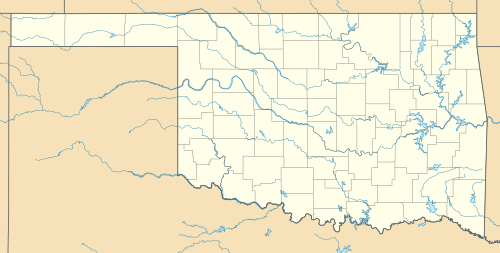Eagletown, Oklahoma
| Eagletown | |
|---|---|
| Unincorporated community | |
 Eagletown  Eagletown 10 miles east of Downtown Broken Bow, Oklahoma | |
| Coordinates: 34°2′3″N 94°34′28″W / 34.03417°N 94.57444°WCoordinates: 34°2′3″N 94°34′28″W / 34.03417°N 94.57444°W | |
| Country | United States |
| State | Oklahoma |
| County | McCurtain |
| Population (2010)[1] | |
| • Total | 528 |
| Time zone | Central (CST) (UTC-6) |
| • Summer (DST) | CDT (UTC-5) |
Eagletown is a small unincorporated community in McCurtain County, Oklahoma, United States. The population was 528 at the 2010 census.[1] Located on Mountain Fork River, about 6 miles (9.7 km) from the Oklahoma-Arkansas border, it was the first permanent Choctaw settlement in the West. It was an important town from 1834 to 1906, and served as county seat for the Choctaw Nation's Eagle County.
History
Some white settlers had moved to the area near Mountain Fork River around the present Eagletown during the early 19th Century, when the area was known as Miller County, Arkansas. but a boundary change in the 1820s put this area into Indian Territory. The white settlers were forced to move elsewhere in order to resettle the Choctaw tribe from Mississippi. When the first Choctaws arrived in 1832, they found fields that had been cleared for farming and cabins that had housed the previous inhabitants. As required by treaty, the Army established a feeding point here for the distribution of rations. An estimated 852 people were receiving rations here in April 1832. By 1834, the number of people here had grown by 1,500.[2]
The Choctaws invited some of the white missionaries to join them in the move to Indian Territory. The first of these was Loring S. Williams in 1832. By July 1832, he established a station he called Bethabara on the west bank of the Mountain Fork. He organized the first church in Choctaw country in 1834 and opened a school the next year. He also obtained the authority to establish a post office in 1834 and served as the first postmaster. Another missionary, Reverend Cyrus Byington, arrived in late 1835. Byington spent 31 years here, and was noted for translating both religious and secular materials into a written Choctaw language that he created. He established the Stockbridge Mission. He was most noted for producing the Dictionary of the Choctaw Language. Byington also supervised the boarding school for Chotaw girls that operated from 1844 until 1861.[2]
Eagletown soon became a trading center on the Military Trace, an important road through Choctaw Country. After the Choctaw Nation created and passed its constitution in 1850, Eagletown became the "courtground" (i. e., county seat) of the newly created Eagle County.[2]
After Oklahoma became a state, more white settlers moved into the former Choctaw territory. Eagle County had been abolished and superseded by McCurtain County at statehood. Some of the settlers became farmers, while others worked in the expanding timber industry. Choctaw Lumber Company built a camp in Eagletown to house the timberworkers. The company also built a railroad (the Texas, Oklahoma and Eastern) that connected to its line in Arkansas.[2]
External links
References
- 1 2 "2010 City Population and Housing Occupancy Status". U.S. Census Bureau. Retrieved October 18, 2013.
- 1 2 3 4 Coleman, Louis. Encyclopedia of Oklahoma History and Culture. "Eagletown." Retrieved August 8, 2013.
